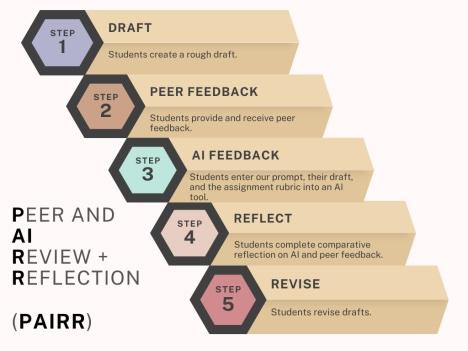In spring 2025, we, Laila ElSerty and Rania Jabr, two Academy of Liberal Arts (ALA) faculty at AUC, considered the amount of time spent in preparing for our classes. We have come to the realization that we spend an average of 15 hours a week preparing for our classes. This has spurred a discussion on how to utilize AI to facilitate teaching, save time, and reduce class preparation stress. Coming from two different programs at AUC, English Language Instruction (ELI) and Rhetoric and Composition, we have started to discuss and brainstorm the utilities of different AI tools to facilitate teaching for faculty members in both departments. We shared our thoughts with a larger group of ELI faculty during ELI’s Neighbors and Bridges Professional Development Day, and the positive feedback we received from the audience has encouraged us to explore the topic even further and find a platform to share our ideas and widen the scope of our audience and readership. We have asked ourselves the question: Should teachers be AI literate? This was the exigency behind writing this piece. In this short article, we will explore how AI can be used to reduce the effort and time spent by teachers in preparation for their classes and how it can also be used to mitigate and solve some of the problems teachers might be inundated with, especially when faced with the need to make decisions about which AI tools to use with their students and how to make responsible choices to engage students and better prepare them for their future. We tend to firmly believe that the goal of using AI by educators is not simply to continue to teach in the very same ways we have been teaching, but to potentially engage in great teaching and offer our students meaningful learning opportunities. AI can be designated as both a facilitator of teaching and a problem-solver.
- Using AI to Facilitate Teaching
To facilitate teaching and learning, the power of AI can be harnessed in numerous ways. The use of the word ‘facilitate’ is an active verb meant to alert educators that they are the drivers of the process of seamlessly integrating AI into their teaching. It also means that AI is here to help us educators to work smarter, not harder. Different AI tools, such as Perplexity, ChatGPT, and Gemini, can be used for creating rubrics and lesson plans, preparing for class activities, and designing quizzes and assessment tools. Let’s explore some of these possibilities!

- Preparing Reading and Listening Tasks and Skill Worksheets
Different AI tools can help with the preparation of reading and listening tasks. When it comes to both reading and listening, AI can be prompted to create critical thinking questions on a reading text or an audio/video, which can be used in class to stimulate discussion. It can also be prompted to create specific skimming, scanning, or vocabulary-related questions. Another way to use AI for reading and listening is by dealing with it as a space for students to collaborate on critiquing, outlining, and/or annotating a text. Different vocabulary and grammar worksheets can also be created with the help of AI. You can feed the tool with a prompt specifying the type of worksheet you require, e.g., puzzles, cloze tests, interactive games, stories, proof-reading and editing worksheets, or any other real-world examples, and AI delivers.
Here is a sample prompt: “Create a worksheet with ten (multiple choice) critical thinking questions for freshmen liberal arts students on the following reading: [insert reading link]”. Educators can easily copy and paste this prompt and use it in any AI tool.
- Creating Lesson Plans and Designing Assessment Tools and Rubrics
When prompted with the class objectives, age group, and topic, different AI tools can be very handy in helping teachers prepare for their lessons. The tools can generate lessons, custom tasks tailored to lesson goals and learning objectives, and adapt content to the needs of different types of students. AI can also incorporate different tech resources to make the lesson interactive. It can generate several assessment tools, such as quizzes, exams, oral presentations, and project prompts aligned with the lesson objectives and content. The same project or test/quiz instructions can be used to prompt AI to generate rubrics for specific tasks. Teachers need to define the task and provide clear instructions on how students are expected to perform. Any relevant details, such as scoring levels and criteria, may also be provided.
Here’s a sample prompt for lesson plan creation: “Create a lesson plan for liberal arts university students on detecting and avoiding logical fallacies in debates and writing”. Teachers can simply copy and paste this prompt and use it in any AI tool.
When asking AI for assistance, always start by informing it about the profile of your students and give it sufficient information about what you want your students to accomplish since providing context will enable AI to tailor-make the worksheets/tasks it suggests.
Here’s a sample prompt: “Create a college-level short reading passage of about 500 words on the topic of “refugee status.” Then, design a skimming task which asks university-level freshmen students studying English to find the main idea, overall topic, or purpose of the passage without reading in detail.” As a follow-up question, you may also prompt AI by using the following: “Design three MCQ scanning questions which require students to locate specific details (e.g., dates, names, places, numbers) effectively”. The steps would be simple since all you need is tocopy and paste this prompt, adjust it to your specific student needs, and use it in any AI tool.
Always carefully review AI output, ensuring you ask AI to refine what materials it produces. Ask AI for different versions of the tasks/materials to cater to the needs of weaker students who may be struggling. These personalization and differentiation strategies (Haelermans, 2022) also assist fast learners who are more advanced than their peers. Added to this, when you describe student progress and your expectations, AI can help suggest formative assessments (Hopfenbeck et al., 2023), which ensure you are able to capture the learning and progress of your students throughout your course.
- Using AI to Solve Problems in Teaching
We all face different challenges in the classroom, and AI can provide mitigative actions for a number of them. We are not claiming that AI is the Oracle, which would provide answers to all questions educators have. We want to designate it as an aid and an assistant, which supports teachers and builds their confidence, as they aim to cater to the needs of their students by making responsible choices when teaching using AI. One issue at the forefront of teachers’ minds is students’ resistance to peer feedback. Another is students’ misconduct or in-class disruptive behavior.
A. Approaching the Peer Feedback Conundrum
We have always heard students questioning the value of peer feedback. The writing program of UC Davis has investigated this problem further and has come up with a technique that would not only help students make the best of the process of peer feedback but also stimulate their reflective and critical thinking skills. The purpose is to guide students as to what they need to improve in their own work and to suggest ways to improve it. Students produce their first draft. They then receive feedback from a peer, a step many students resist, as they sometimes do not see the value of peer feedback. After this step, students feed an AI tool with the writing prompt, their first draft, and the rubric to receive AI-generated feedback on the same draft. At this point, students are asked to compare the feedback they received from their peers and the feedback they received from AI. As a final step, they reflect on the two types of feedback and produce a revised version accordingly. This process is called PAIRR “Peer and AI Review plus Reflection” (UCDAVIS, 2025).

PAIRR Model by UC Davis Writing Program
B. Responding to Students’ In-class Disruptive Behavior
Another issue is students’ misconduct or in-class disruptive behavior, which can take many forms. We have investigated how AI can be used to handle students’ disruptive behavior, and we have found that AI can be supportive in providing tips for addressing numerous types of disruptive situations. For example, some AI tools provide practical suggestions and advice on what to do if students do not come prepared for their class or choose to use their phones during classes. They also offer tips for encouraging students to come to class prepared, having done the required reading. When prompted to make specific, practical suggestions, AI makes relevant, concrete suggestions in the form of specific pedagogically sound output, namely tasks and activities to cater to the needs of students and address teacher concerns. Class management tips and techniques are generated to suit the level of students and to address problems facing educators. For example, when prompted to offer suggestions regarding how to best deal with tardiness, Al responded by suggesting making the beginning of class “valuable”, “engaging”, and “memorable”, so students would not be willing to miss. Quizzes, polls, debates, and thought-provoking discussions were some suggestions. Not only this, but AI also suggested focusing on connecting punctuality to professionalism, an acquired skill which employers seek in potential employees. It also suggested reminding students that university is the place to learn this workplace skill. In more heterogeneous groups with varied abilities and even disabilities, AI can be very useful in providing customized tips tailored for a specific group of students with “specific learning needs”.
For example, when given the following prompt, AI provided a holistic plan on how to deal with a group of students with varying needs: “Suggest class management tips for a liberal arts faculty member to deal with a group of 15 college students, three of whom are diagnosed with ADD, two have ADHD, and three have hearing-related disabilities. Give suggestions on seating arrangement, tailor-make activities, provide formative assessment tasks, and suggest different types of instructions.” AI output provided clear and specific instructions for the following: having accessible seating, using small group pods, using active multi-sensory activities, and breaking complex tasks into smaller, manageable parts. It also provided assessment-related feedback in the form of using frequent low-stakes check-ins, e.g., “Bell Ringers and Exit Tickets,” and giving multimodal (oral and visual) instructions. Added to this, AI suggested a number of additional tips in the form of specific guidelines, namely the need to ensure consistency, to establish a class routine, and to offer positive reinforcement.
Conclusion
Whatever AI tool you choose to use and whatever your teaching needs are, always consider adding context when promoting AI to generate a lesson plan, assessment tasks, or a worksheet. This will enable you to level up your AI prompts. Always remember to prompt AI to ‘act as +add role’ (student or teacher), to prompt AI to ‘create a + task’ (type of task), or to prompt AI to ‘show as + format (worksheet or quiz). The goal is to craft prompts which generate smarter, practical responses. You still need to always revise and double-check AI output. This means we should not blindly trust AI, educate our students to use AI responsibly and to question AI output as well, and always apply human decision-making and judgment.
Note: This article was written by humans, and AI was not used to generate it.
References
Haelermans, C. (2022). The effects of group differentiation by students’ learning strategies. Instructional Science, 50(2), 223-250. https://link.springer.com/article/10.1007/s11251-021-09575-0
Hopfenbeck, T. N., Zhang, Z., Sun, S. Z., Robertson, P., & McGrane, J. A. (2023). Challenges and opportunities for classroom-based formative assessment and AI: A perspective article. Assessment, Testing and Applied Measurement, 8. https://doi.org/10.3389/feduc.2023.1270700
UCDAVIS University Writing Program. (2025). Peer & AI Review + Reflection (PAIRR). https://writing.ucdavis.edu/pairr?fbclid=IwZXh0bgNhZW0CMTEAAR7AOtTSb-rny2q8gHRPA3Ch7BdxkM3o6IXmt4wfY9UUJAg1rugUuXjHt5YNzw_aem_vXXYRCw-0qH1dbNl4KzBOQ


